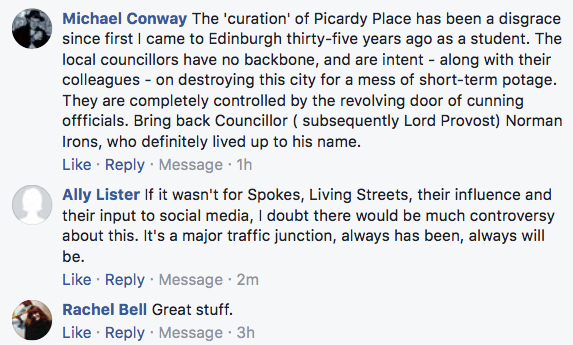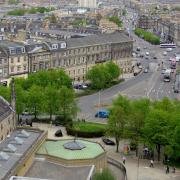
FIVE BIG HITTERS ON PICARDY PLACE AND WHY COUNCIL MUST THINK AGAIN
Pressure has mounted on Transport and Environment Committee members as open letters, articles and social-media messages over the last week have articulated widespread public opposition to the Council's latest plans for Picardy Place.
A representative sample of hundreds of Facebook and Twitter messages addressed to or seen by Spurtle appear here. Despite our best efforts, we found only one in favour of the Council's plans.
Below, we reproduce (mostly unedited) five considered communications: from the Picardy Place Joint Campaign (with an influential list of signatories), Leith Central Community Council, New Town and Broughton Community Council, Living Streets, and Spokes.
The groups have approached the Picardy Place problem from different perspectives and areas of expertise. Consequently (apart from as joint signatories in the first letter below) there is rarely complete unanimity in their observations and demands. However, most agree on insufficient prioritisation of cyclists and pedestrians under current plans, the desirability of considering alternatives to a gyratory, and/or on the logical requirement to delay making a decision about redesigning Picardy Place until the Council's City Centre Transformation project has reported its findings on long-term traffic management in Edinburgh.
If you wish to contact your committee members or your local councillor before tomorrow's meeting, you can find their contact details here. For Transport & Environment Committee members, go here.
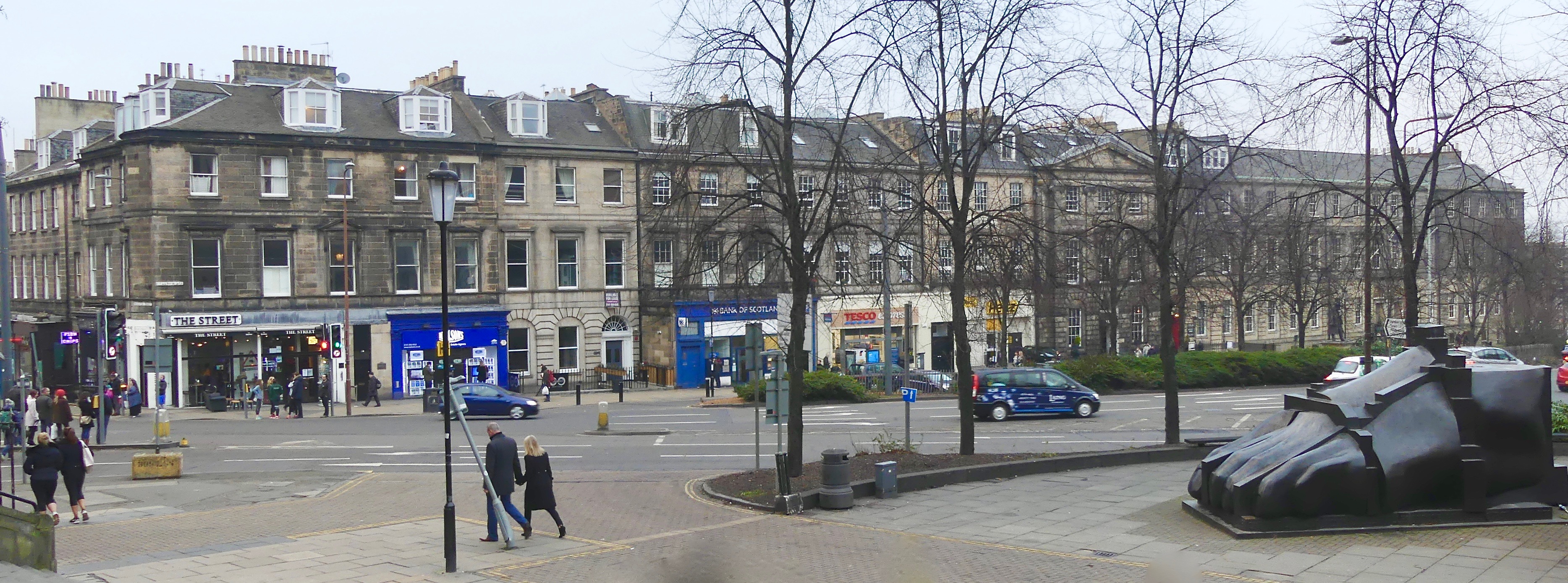
PICARDY PLACE JOINT CAMPAIGN
Dear Transport & Environment Committee Member
New Proposals From CEC For Picardy Place
As the Transport & Environment Committee considers the Council’s proposals for Picardy Place at its meeting on 25 January, the undersigned organisations and groups wish to make a number of points. The first is to acknowledge that the Council has responded positively to the consultation and brought back a design proposal that aims to meet a variety of concerns, including the need for public space outside the Cathedral and the Omni Centre and improved provision for cyclists, those attending the Cathedral and pedestrians crossing outside the Playhouse.
However, we are of the opinion that the proposals do not go far enough because a gyratory traffic management system remains integral to the design proposed. Consequently, the proposal does not address sufficiently opportunities to: improve the character of this Gateway to the New Town in line with the best practice requirements of a World Heritage site; create a high quality public place designed around the needs of pedestrians, cyclists, parishioners, visitors and for those for whom this area is part of their local neighbourhood; and reduce traffic pollution in the area.
For these reasons, we request collectively that the Committee does not decide to proceed to a decision on the future of Picardy Place. Instead, we ask that the Council undertakes a formal and open review of alternative designs to the gyratory to bring the design within the Council’s own policy aspirations, and maximises the opportunity to improve the public realm and avoids a design excessively dominated by traffic considerations.
It is recognised that the Council is operating under a number of historical constraints that may restrict its present room for manoeuvre, although we are not aware of the exact conditions that pertain with this.
If the Committee were to conclude that these constraints do not provide sufficient time just now to consider alternative designs, we request that the matter is not allowed to rest and early consideration is given to further enhancements of the Picardy Place design that reflects the Council’s work on the Central Edinburgh Transformation. This would require, amongst other things, that any works are future-proofed and have flexibility built in.
All of those represented here are willing to engage constructively with the Council and others now and in the future to achieve the best design for Picardy Place.
We thank you for your attention in this matter.
Sent on behalf of:
Terry Levinthal, Director, Cockburn Association
Adam Wilkinson, Director, Edinburgh World Heritage
Dr Richard Dixon, Director, Friends of the Earth Scotland
Harald Tobermann, Vice Chair, Leith Central Community Council
David Spaven, Convener of the Living Streets Edinburgh Group
Martin McDonnell/Peter Williamson, Co-Leads, Picardy Place Joint Campaign
Dave du Feu, Lead Organizer, Spokes
Mgr. Patrick Burke, Administrator, St Mary’s Catholic Cathedral
Ann Laird, Chair Technical Committee, Scottish Civic Trust
David Jamieson, Partner, Zone Architects, Edinburgh
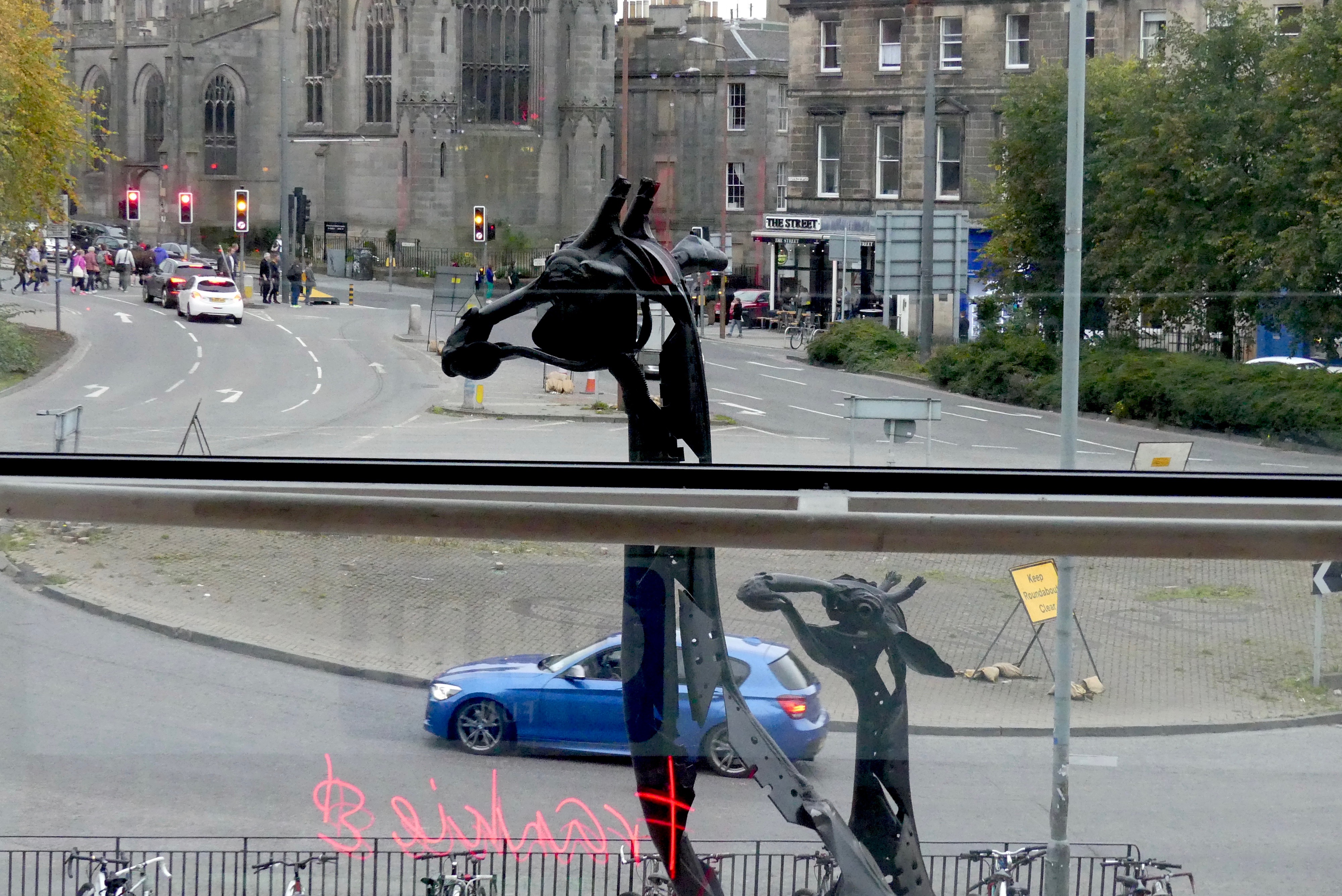
LEITH CENTRAL COMMUNITY COUNCIL
Dear Transport & Environment Committee Member
As the Transport & Environment Committee considers the proposal for Picardy Place at its meeting on 25 January, I write to you on behalf of Leith Central Community Council to request that the Committee does not proceed to a decision on the future of Picardy Place at this point.
The reasons for this are that
a) the consultation on this highly important matter failed to offer sufficient opportunity to consider designs other than the “gyratory” proposal, backed by the necessary information to allow a properly informed assessment of their relative merits to be undertaken
b) the design now before the Committee is so full of compromises, that it is, indeed, compromised: the proposed junction design is ugly, difficult to "read" and painful for any mode of transport to traverse
c) the proposal is - quite possibly unnecessarily - beholden to an outline sketch, drawn up as part of the GAM, that focuses on Picardy Place in isolation, instead of the wider context, and in particular seems to be ignorant of the timeline of the Central Edinburgh Transformation Scoping Report and its entirely admirable strategic vision
d) there are serious doubts that the design is an improvement over the current layout; indeed, the report itself concludes that "it is likely to operate with delays to bus services that are similar to those currently experienced" (3.40)
We therefore wish the Committee - together with the various stakeholders - to embark on a full evaluation of a range of design options in addition to the gyratory, instead of simply further variants of the gyratory proposal, and for the relative merits of these alternative designs to be given systematic consideration.
Any shortlisted proposal/s emerging from such a process should
- fundamentally seek to improve the character of this important node which is simultaneously a gateway to the New Town and to the most densely populated areain Scotland (with the lowest car ownership per household in Edinburgh), and a link to the Old Town and the Southside of the city
- provide a high quality public place designed around the needs of pedestrians, cyclists, parishioners, visitors and for those for whom this area is part of their local neighbourhood
- not be determined predominantly by transport management considerations, prioritising vehicular movements and creating a multitude of traffic islands in a sea of traffic, but pay proper attention to all aspects of ‘place-making’ as enshrined in existing Council and Scottish Government policies
- chime - at least in anticipation - with the wider changes that the Central Edinburgh Transformation Scoping Report will bring and with outstanding works to Leith Walk
We urge you to demand a better future for Picardy Place and central Edinburgh than that envisaged by the present proposal. An alternative simpler, more easily "read" design very likely would also come without a £1.5m price tag.
Thanking you in anticipation.
Yours sincerely
Harald Tobermann
Vice Chair
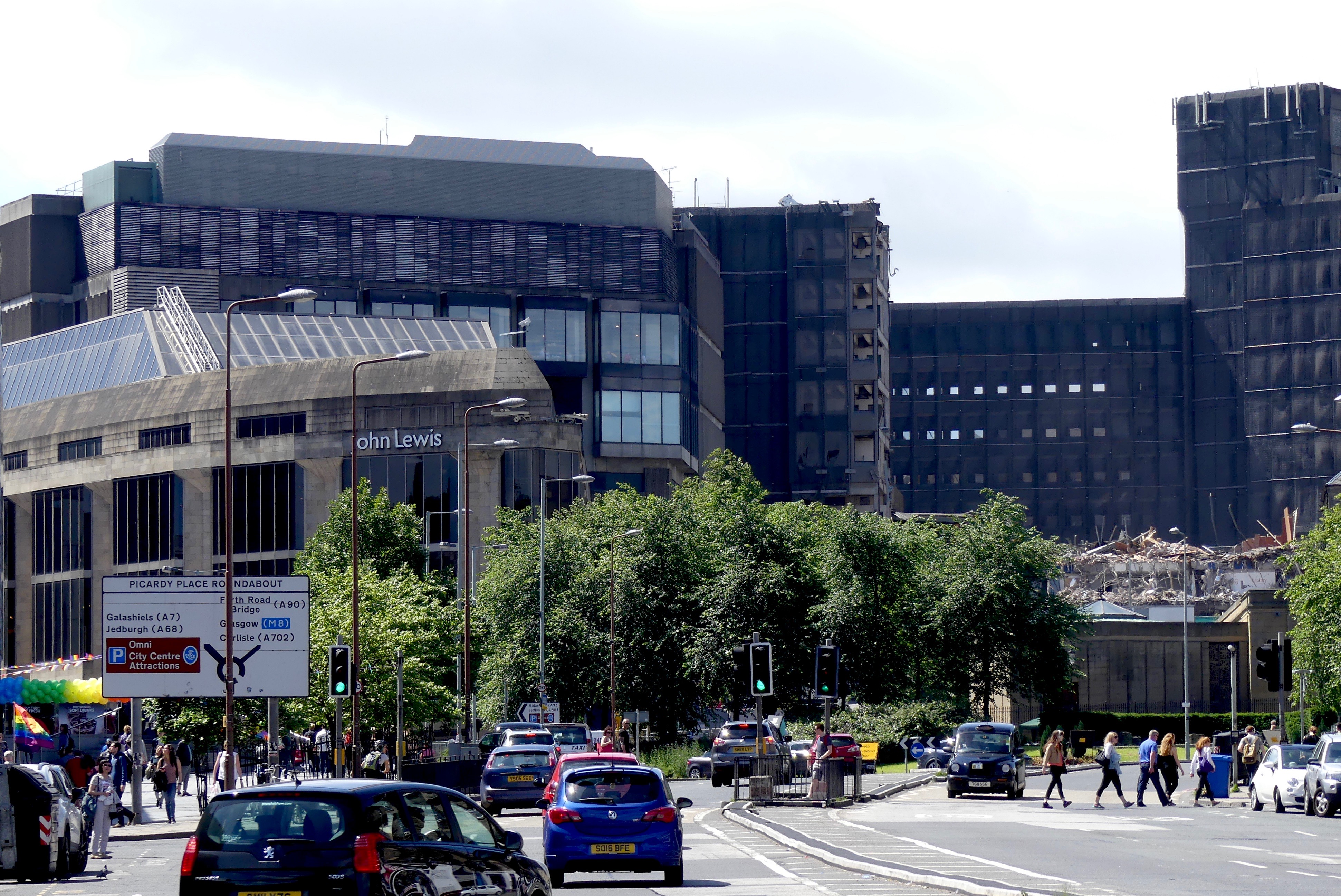
LIVING STREETS
Dear Councillor
Living Streets Edinburgh Group has been considering the latest design changes in the Council’s report and plans published on 18th January. While the amended design – compared to the current situation – does include major improvements for cyclists, we strongly dispute the claim in the report that it provides ‘very significant improvements for public realm and walking’. That claim simply does not stand up to scrutiny.
Our analysis of the latest design iteration compared with the current (pre-Leith Street closure) situation on the ground, suggests – in terms of its impact on the safety and convenience of walking – is that, incredibly, there will actually be a deterioration in the pedestrian environment. These are our conclusions on the design elements which concern us most:
- gyratory v current roundabout – both unfriendly for walking, so little or no change
- pedestrian crossings – little change, other than the crossing at the Conan Doyle corner increases from 2-stage to 3-stage, which is a backward step
- footway width – looks to be narrower on the south side of York Place, and effectively narrowed by the ‘Floating Bus Stop’ on the east side of Leith Street
- cycleway bisecting footways – there are none at present, but the new plan introduces significant pedestrian / cyclist conflict potential on the Leith Street footway (east side), particularly around the Floating Bus Stop
- green space / public realm – lost on the north side of Picardy Place, retained in front of the cathedral, but the new island is relatively inaccessible and is surrounded by traffic and air pollution: so, little change overall.
Therefore, while traffic stands to benefit most significantly from the changes at Picardy Place, the mode of transport which is supposed to be at the top of the Council’s list of priorities – walking – has been treated as very much a secondary issue, with the opportunity to transform the walking environment completely missed. Taking a wider perspective, the Council report makes no mention whatsoever of the widespread opposition to the gyratory concept, nor of the Council’s traffic reduction targets – which this scheme will undermine.
We are also very concerned with the reports proposal to redirect £1.5m from ‘the existing Carriageway and Foootways block capital budget; in order to meet the shortfall in the cycleway and public realm works. We suggest that, given the emphasis on new cycleways, the cycling budget – with possible match-funding from Sustrans – would be a more appropriate source.
We urge you to delay any decision on the Picardy Place scheme until sustainable alternatives have been properly evaluated and addressed within the framework of the City Centre Transformation project.
Regards
David Spaven
Convenor, Living Streets Edinburgh Group
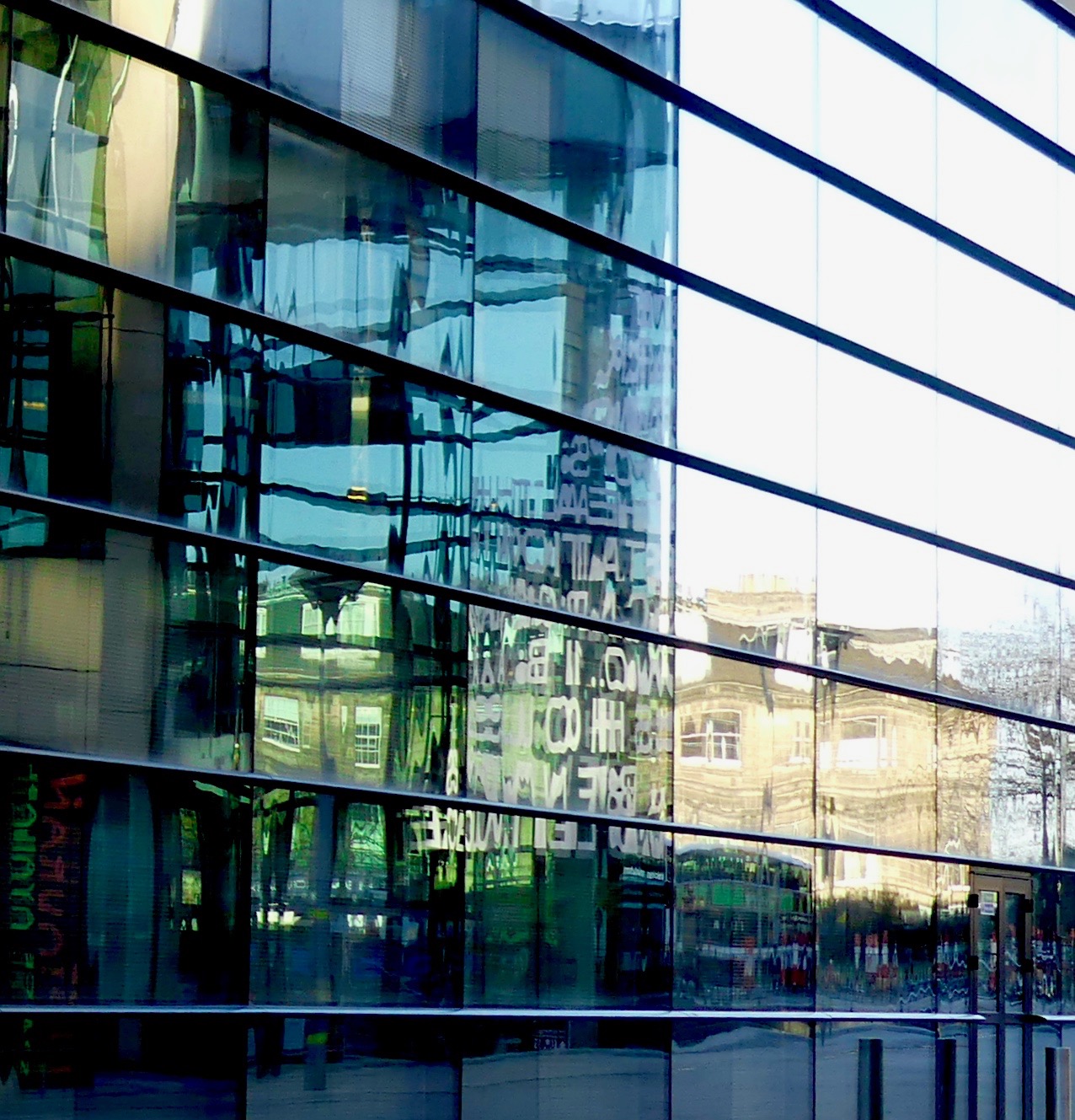
NEW TOWN AND BROUGHTON COMMUNITY COUNCIL
To: Veronica MacMillan
Committee Services
Transport and Environment Committee
City of Edinburgh Council
Dear Ms MacMillan
I am writing on behalf of the New Town and Broughton Community Council (NTBCC) regarding the report on the redevelopment of Picardy Place for the 25th January meeting. I hope that you will circulate this to Committee members in advance of the meeting.
Overview
- The NTBCC notes that the revised proposals address several of the concerns regarding pedestrian and cycle access, the use of public space and the Paolozzi statutes raised both by NTBCC and other stakeholders. However, we think that there are aspects of the design which are still suboptimal, especially regarding the bus tram interchange and the ban on the left hand turn from York Place into Broughton Street.
- Some of us have a more fundamental concern that the gyratory will create traffic merry go round, and that it is simply the wrong approach for the gateway to the World Heritage Site. Others take the view that until traffic levels fall, the gyratory remains the optimal way of accommodating the various competing demands on the space.
- The report briefly touches on alternatives design, and why they are not being followed up, but this has not satisfied critics of the gyratory layout within the community. The local Picardy Place Residents Group calls for the Committee to defer a decision on the future of Picardy Place until alternative design options not involving a gyratory can be considered with local stakeholders. There remains anger in the community at the 'take it or leave it approach' of the Council to the redesign of the Picardy Place area, which stems largely from the manner in which the Council signed up to a detailed design in the GAM with a lack of transparency and without meaningful consultation, and then sprung the design upon us in September 2017.
- By contrast, the recent short consultation, which was the first which sought to engage the community and listen to what was being said, has already had the effect of significantly improving the current proposal. Given this, we would support a pause in decision making to allow for further consultation. We think this has the potential both to lead to a better design as well as to increase community acceptance of the eventual approved design. That said, NTBCC would oppose any design which did not maintain the Leith Street route between Broughton Street and the Bridges for all vehicles.
- Other benefits of the pause would be that it might enable a decision on the tram extension to be taken at the same time, which would provide more certainty as to the design, and allow roadworks and tram works to be more integrated than has hitherto been the case in Edinburgh. It might also enable the decision on the design to be taken in the wider context of the Central Edinburgh Transformation project.
- However, we recognise that the Committee will have to balance the benefit of further consultation against the advantages of taking a decision now which would enable the GAM to be renegotiated and work to commence whilst Leith Street is still closed.
Comments on the detail of the design
- We are pleased to see the expanded public realm on front of the Cathedral, which, with the cycle lanes now moved to the triangle, appears to be large enough to accommodate the Paolozzi sculptures if that is decided to be their location. We also note the plans to allow a path for wedding and funeral corteges to draw up in front of the Cathedral, and the commitment to reinstate trees, which hopefully will screen pedestrians from the worst of the traffic rumbling by. We would ask that the Committee seek assurances from officials that all these elements can be accommodated in the available space, as the sketch layout provided by Optimised Environments does not include the funeral cortege path
- We much prefer the proposed segregated cycle lanes running through the triangle, as not only does it avoid pedestrian/cycle conflict, but it shortens desire lines and has the potential to animate the triangle, which we feared might become a dead space, especially if the tram is not proceeded with. We also welcome the segregation of the pedestrian and cycle crossings and the provision of a pedestrian crossing from Picardy Place to outside the Playhouse.
- Equally we welcome the Council’s commitment at para 3.31 of the report to retain this space for public realm and other facilities associated with the potential tram stop, and that, should the potential tram stop not be required, there would be an opportunity to review the size and potential use for this area. We think this flexibility is important in the longer term should a combination of the Central Edinburgh Transformation plans and other measures, such a low emissions zone and improved public transport, reduce traffic volumes to the extent that a gyratory is no longer required.
- We note that the Paolozzi sculptures might be relocated to the triangle, and, with one caveat, we would defer to the Paolozzi experts on the appropriateness of this. Our caveat is that we suspect parents might be reluctant to allow their children to play on them as Paolozzi wished, surrounded, as the triangle will be, on all sides by traffic, in the way they did when they were outside the Cathedral. We also urge that efforts are made to landscape the triangle to give it a sense of place, for example by providing hedges and trees to screen the cycleways and footpaths from the nearby traffic.
Our major remaining concerns and questions
- The bus stops for east west traffic proposed at the Cathedral still are quite far from the proposed Picardy Place tram stop, as are the York Place stops for bus passengers wishing to change to the tram should it be extended down to Leith. At Friday’s briefing someone questioned whether the buses could run along the 'trambahn' to enable them to stop by the tram stop going west east. We do not know if this is feasible, but would urge that this be explored. If neither the bus stops not the tram stop can be moved, then we urge that very careful consideration be given to signage as unless public transport users are clear how to switch, they will not support the hoped for modal shift to tram. We wonder whether Lothian Buses would consider installing a small information centre and public toilets in the triangle, both of which would be a boon for public transport users. Through ticketing is also essential to make the interchange function properly.
- We remain concerned that the ban on the left hand turn from York Place into Broughton Street, besides inconveniencing local residents, will also displace traffic onto Union Street or East London Street, or alternatively though the second New Town. Residents of the eastern New Town are already very concerned about the high volumes of rat-running through their streets which has persisted since the Tramworks and are understandably concerned at any change that has the potential to add to it. Whilst we note that the report suggests at para 3.27 that banning it may serve to minimise congestion in York Place and thus traffic displacement into the second New Town, and cites traffic data and modelling, residents are unlikely to be reassured by this without having a chance to study the data and modelling on which this assertion is based.
- Resident’s scepticism has not been helped by the Council’s failure to take effective steps to enforce the 20mph zone on the residential side streets of the second New Town, where drivers continue to speed with impunity. Many think that the Council should concentrate on ensuring that city centre drivers reach their destinations by reasonably direct routes at no more than 20mph, rather than lengthening journeys by banning left and right turns (such as the proposed ban on the RH turn from London Road to Leith Walk which will only serve to divert traffic to Picardy Place and which NTBCC strongly opposes). We urge the Council not to finalise their position on either ban until we have had a chance to study the data and modelling, and consider what further consultation might be carried out on this with local residents and businesses.
- The design suggests that all residents’ parking will disappear from Picardy Place. Whilst we understand that this will be difficult to accommodate on Picardy Place itself, we ask the Committee to ensure that officials consult with residents to ameliorate matters as far as possible, perhaps by providing suitable extra residential bays on neighbouring streets.
- In conclusion, we reiterate that the process by which we have finally reached this design was far from satisfactory, we find it disturbing that the Council was seriously contemplating starting work on the September 2017 design in October. Had the Council taken proper steps to consult about the detailed design before entering the GAM agreement, we could be at a better place now. We hope that the Committee will recognise that consultation with the community is central to achieving good planning outcomes going forward with the equally important George Street and First New Town design process and the Central Edinburgh Transformation project.
Yours sincerely,
Ian Mowat
Chair NTBCC
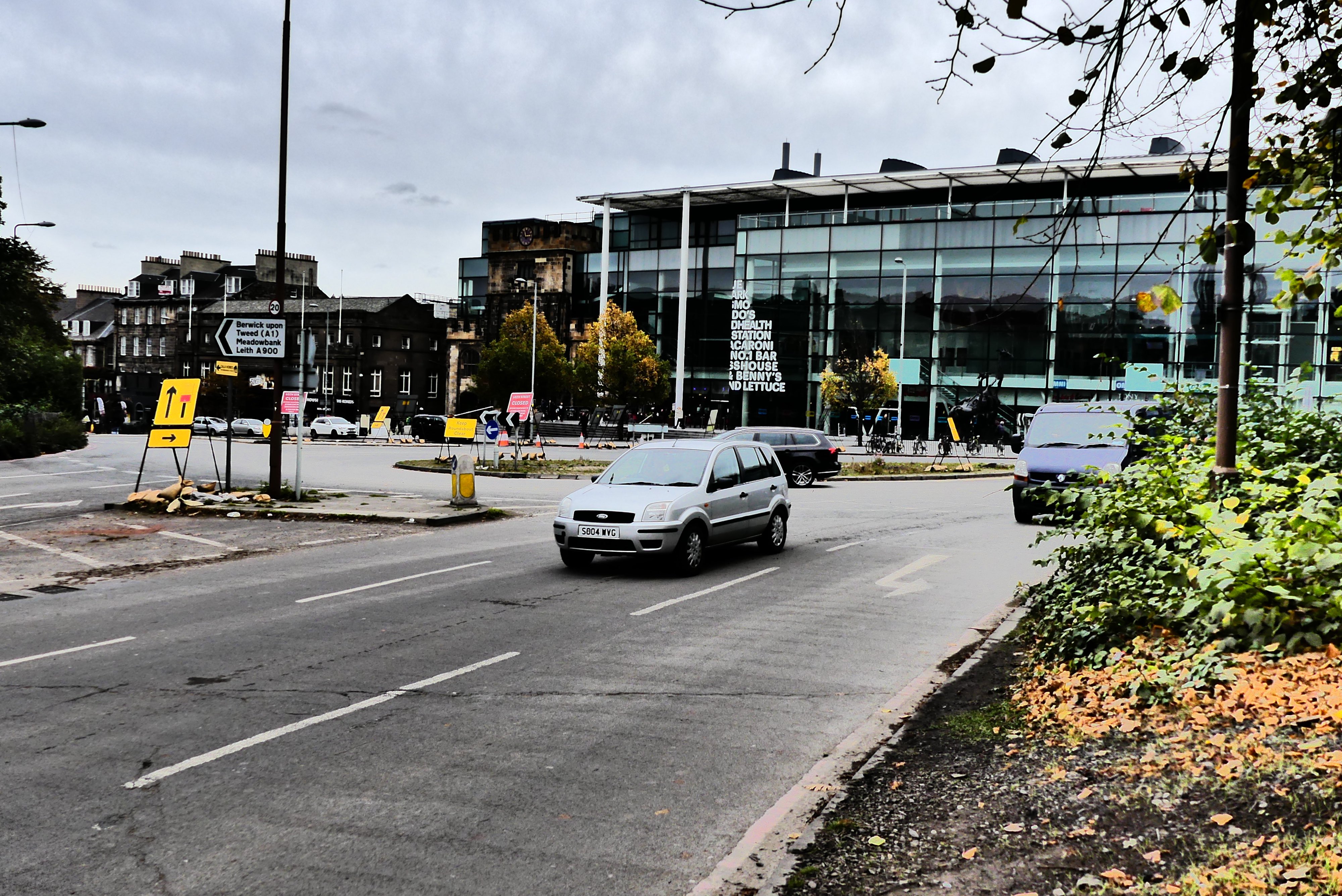
SPOKES
We are writing with our views on the Council’s proposals for Picardy Place, as described in the Committee papers for the meeting on 25 January.
Overview
1. The proposals following December’s consultation represent a considerable improvement for cyclists and pedestrians as compared to earlier plans. They are also a huge improvement on the current roundabout as regards cycling safety and the ability to attract more people to travel by bike.
2. Nonetheless, the basic concept of a gyratory is very disappointing – the roadspace itself is excessive and the area within the gyratory is to some extent sterilised as public space due to traffic on all sides, as can be seen with existing gyratories and very large roundabouts such as Calder Road, Granton Square and Cameron Toll. With a non-gyratory solution, all space would be easily accessible on foot and the conditions for cycling, walking and, especially, lingering, could be far better.
3. Regrettably, due to the GAM agreement, as described in the Committee papers, and potential major financial and contractual implications, it seems likely that the Committee will approve the gyratory although we urge against this. Should it be approved, however, there remain steps which can be taken to further improve the present plans to provide safer and more attractive cycling and pedestrian conditions.
The gyratory
4. The principle of a gyratory has been a clear Council intention for at least 10 years, and Spokes has actively opposed it throughout – long before the current controversy and indeed long before the GAM agreement. For example, back in 2010, we wrote to then Transport Convener Cllr Gordon Mackenzie laying out arguments most of which remain valid to this day, albeit, fortunately, the hotel has now gone.
5. It was extremely unfortunate that the Council, the government and the St James developer then ‘cemented’ the gyratory into the GAM agreement, so that (as we understand it, and as the Committee papers suggest) there would be very significant financial implications were it removed. Furthermore, although there had been consultation at much earlier stages (e.g. the 2009 Picardy Place Development Principles) there was no meaningful consultation when, years later in 2016, the gyratory was cemented into the GAM, with no real public awareness of what was happening – leading to today’s problems.
6. By the end of the present year, 2018, two major uncertainties, which are critical to the future of Picardy Place, are likely to have become much clearer, if not finally resolved. Namely, the proposed tramline extension and the proposals for the City Centre Transformation. It is tragic that decisions on the future of Picardy Place are being taken in advance of those decisions, rather than as part of an integrated solution.
7. Finally, despite public perceptions to the contrary, policies are succeeding in gradually reducing city centre car traffic (as also in some other cities) – for example see data from the regular Spokes rush-hour traffic counts and Census data. We do believe that the Council wishes to maintain this trend, and the redesign of Picardy should be an opportunity to do so. Instead, through non-holistic policy making, the Council appears to have boxed itself into a corner through decisions such as the GAM and the planning approval some years ago for a massive increase in car spaces in the St James development.
8. In summary, if the GAM can be renegotiated to allow a re-think on the basic Picardy design, in conjunction with the Transformation process, that should happen. However, if the gyratory is built, it has to be seen as no more than an interim solution.
Leith Street
9. The Committee papers also refer to the future of Leith Street. Spokes has argued for its closure to be maintained (except for buses and emergency vehicles) once the current Leith Street works are complete, for the benefit of pedestrians and cyclists – also bearing in mind that their numbers likely to dramatically rise once St James opens.
10. We are aware, however, of concern by some New Town and London Road residents that this means possible deterioration in their local areas. We therefore suggest a compromise whereby Leith Street would be fully reopened to downhill traffic, whilst only buses, emergency vehicles and possibly taxis would be allowed uphill (private traffic uphill could be permitted as far as the St James car park entrance and/or possibly Calton Road). These suggestions would eliminate any queuing elsewhere currently caused by diverted buses on the road or at bus stops, and should greatly reduce or eliminate any rat running. Local mitigation measures could be considered if any such problems did remain. Furthermore, all Leith Street options would remain up for discussion as part of the Council’s Transformation process.
11. If Leith Street fully re-opens to all uphill traffic, the difficulties for both pedestrians and cyclists (supposedly the Council’s and the government’s top priority transport groups) will be acute. As Living Streets point out, the current plans mean an uphill footway which narrows at one point to a mere 2m, well below the Council’s own standards. And there is no provision at all for cyclists, travelling slowly uphill in this relatively narrow carriageway besides lorries, cars and buses. Restriction to only buses, taxis, etc would allow one of the two uphill traffic lanes to be converted to a wider footway and an uphill cycleroute, thus resolving these difficulties and encouraging more travel by foot and bike.
Detailed Picardy Place improvements [including tram stop design]
12. Should the current plans be approved by Committee, there remain issues of detail which could improve safety and permeability for travelling by bike and for walking. In terms of cycling, these include the detail of how cyclists enter and leave Broughton Street, the need for a cycle/pedestrian crossing to Union Place, and the specifications of the cycleroutes. We trust that any decision by the Committee on the overall plans will not prevent the possibility of such minor tweaks.
13. Whilst somewhat more substantial, we urge a re-think on the design of the tram stop, in two respects …
- Rather than a central platform, there should be two platforms, outside the tracks, as at several existing stops in the system. This would gain a significant amount of roadspace which is currently wasted beyond both ends of the platform, as the tracks diverge – at the west end of the stop that space would be extremely useful in detailed design of the very tricky Broughton Street junction, and at the east end would make a pedestrian/cycle crossing simpler. Adjacent tramlines, rather than separated tramlines, also allow more direct (and therefore safer) cycle crossings – a vital consideration given the existing record of bike/tramline crashes and injuries. Tram passengers too would benefit, by being able to get off the platform anywhere instead of having to walk down the platform to the tramline crossing point.
- As is common in European tram systems, selected bus routes should be able to use the tram bahn (particularly near the tram stop) and use the platforms. This would ease pressures on roadspace and, most important, would hugely enhance Picardy’s ‘transport interchange’ function – which is widely perceived to be deficient under the current proposals.
------------------




